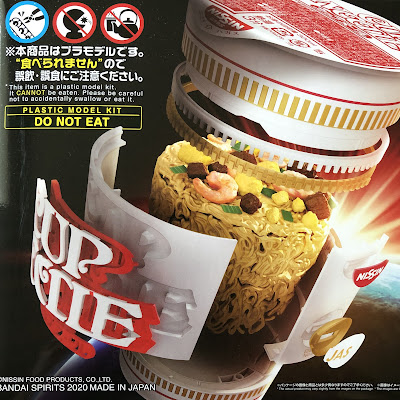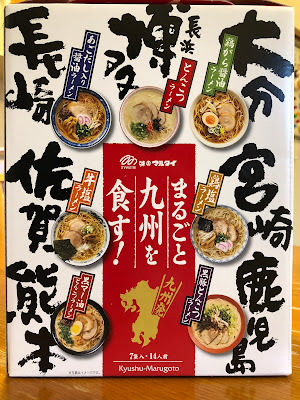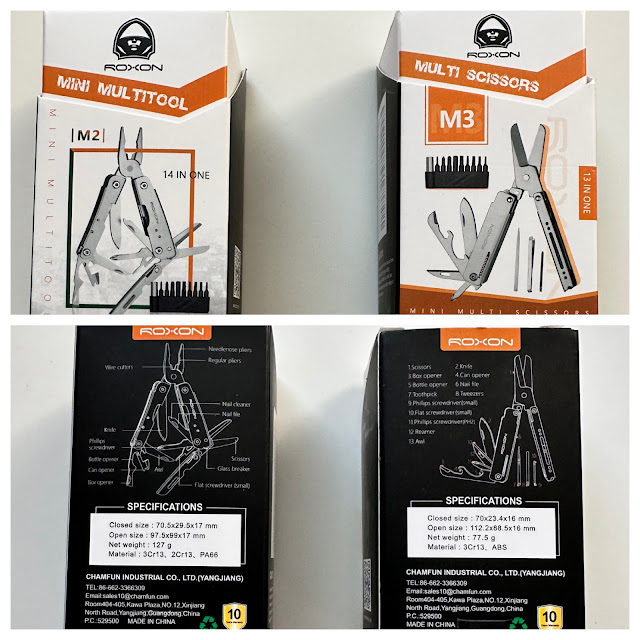I believe it was in October of 2019 when Nissin Japan's Twitter feed posted a mockup of a Cup Noodle that was assembled as a model kit. The original photo was actual food and cup components that were on a runner as a joke. It was kind of funny and kind of cool. I guess they must have gotten enough feedback or someone in the PR department had the idea to actually have a real model kit produced. I heard about the Cup Noodle model kit in the early part of 2020 and placed a pre-order for its release in September of 2020. Bandai produces this kit and they make great models, so buying one wasn't a risk. This model kit sold pretty good. You can order this model kit from Japan at amiami.com or hobbylink and it costs about $20.
I received my kit in October and it sat on a shelf for three months after my initial inspection of the kit. I promised myself I would get it built before the end of the year and I did it today on the 28th of December, just in time to be my last blog post for the year!
 |
Closeup of the box art for the model it. It is very dynamic and makes the model kit look very exciting indeed with the cutaway!
|
From the picture above you can see warning labels like THIS IS A PLASTIC MODEL, DO NOT EAT, and DO NOT POUR BOILING WATER. I think the BANDAI people had a fun old time creating this model kit as they are putting a lot of humour into it. I have to say that the finished cup itself is very realistic and that you would have some trouble telling a real cup from the model at a bit of a distance.
If you have been to the NISSIN Ramen Museums in Yokohama or Osaka, you will have seen cutaways of a Cup Noodle like on the model there. When I was assembling this kit, it actually reminded me a little of visiting the museum in Yokohama which was a ton of fun.
 |
The model kit is a pretty standard size box that is thicker than the smaller HG Gundam model kits that Bandai produces. I build a SD Unicorn Gundam just before assembling this kit.
|
 |
I opened up the box and pulled out the model runners and assembly instructions to have a look at them. In the meantime, my cat came into the room and thought "Ooooh. A box. A box. A comfortable box." So the model kit box fits a 10 lb cat. Needless to say, I had to lure kitty out of the box with a treat.
|
Part One: The Model Kit
After breakfast today, I popped out the model kit again and started assembling it. This time there was no cat in the box, but she did sit on the table and watch me make interesting noises and crinkly sounds with all the plastic wrap and pieces. There are a fair number of components to this model, but it isn't as hard as assembling a Gundam model with all of the poly cap joints and body parts. You would think that a cup wouldn't have that many components, but you're wrong! When I first opened the box I though there were a lot of gear type pieces, but they are for the various bits of detailing on the cup. Yes
Modern plastic kits from Japan have components molded in colour now and can even have multiple colours on one runner. This kit and even Gundam robot kits also do not require glue, which makes them way more fun to assemble! A pair of flat bladed model nippers to cut the pieces out would be very useful, but it is possible to cut the pieces out with small wire cutters or scissors. If you don't assemble models regularly, make sure you know where to cut - think TWICE before cutting - look at the directions to see what the piece looks like or how it fits if you are not sure! The instructions are now in both Japanese and English which is a nice touch. I went back to look at a 2019 model kit of the ARX-7-XL-2 Arbalest from Full Metal Panic that I have and those instructions are also bilingual, so it has been like this for awhile. Still, sometimes the instructions are a little vague, so a bit of thinking is required to properly assemble some parts.
 |
Partially assembled top of the cup. There were many rings and coloured components to put together for a really nice effect. The picture here shows an actual Cup Noodle from Japan as a reference model.
|
 |
You can see how the bottom of the cup and the top of the cup are assembled here in this shot. It is quite interesting to build and yes, the parts do have to fit in a particular way.
|
 |
This photo shows the sides of the cup and the Cup Noodle logo, what I would call the center piece of the model kit. You can see that you assemble the logo from the pieces on the runner and that there are little plastic shrimps on the runner too.
|
 |
The letters fit into the red plastic logo form. It creates a very nice effect.
|
 |
The finished logo - minus some teeny tiny sticker to separate the L and the E in NOODLE. In my instant ramen reviews I always critique the packaging design. Having to assemble a logo and seeing how the lettering fits together gave me a new perspective on things. Lettering can be very complex and well crafted.
|
 |
The completed CUP NOODLE logo inserted into the front side panel of the model kit. It looks really good.
|
 |
Comparing an actual cup noodle and the model which is a 1:1 scale kit. How often does anyone build a 1:1 scale model? The model has sharper detail than the printed cup and it is heavier. The model is a really good representation of the actual product!
|
 |
Assembling the noodle block. There were ten pieces to assemble for the noodles, which wouldn't fool anyone, unlike the cup itself.
|
 |
The completed model kit compared to the actual Cup Noodle. The model looks really good and most of the seams are almost invisible. Under some more diffuse light you would find it hard to tell which is the real cup noodle. The model even comes with a re-usable peel-able top lid.
|
 |
So, what does the completed model look like? I peeled the lid off of both the real cup and the model to show you what they look like side by side. The model is pretty good looking, but you know which is plastic and which one isn't. There are little green onion bits for the model, but they keep falling down the sides of the cup - kind of amazing actually.
|
 |
I love the fact you can take the front panel of the model kit off to reveal how the noodle block sits in the cup. You can't do that with the real cup! This also reminds me a lot about the Nissin Cup Noodle Museum exhibits.
|
 |
The model kit is in the back, and the rehydrated cup noodle is in the foreground. Yes, I added boiling water to the real thing and ate it! Actually eating a real Cup Noodle after assembling the kit was really satisfying - tasty noodles too!
|
 |
Another closeup of the front of the real cup compared to the model on the right.
|
 |
Another closeup of the back of the cup compared to the model on the left.
|
Part Two: Actual Cup Noodle Quick Review
I haven't reviewed one of the original Japanese Cup Noodles in a long time. I thought it would be nice to do a quick review of this product which was the very first cup of noodle introduced anywhere in the world in 1971. When Cup Noodle was first introduced, it didn't have a market and Nissin had to do product demos in Ginza to build awareness. It only took off in popularity after emergency crews were seen in the news slurping these noodles on a cold day. There is an entire manga Project X Cup Noodle (out of print English translation) which documents the drama around creating the original Cup Noodle.
 |
Project X: Cup Noodle - who knew creating Cup Noodles was this dramatic! I like the bit about finding the right kind of shrimp that looks orange.
|
The regular Cup Noodle has a soy sauce based soup that is quite savoury and pleasant. There have been many kinds of Cup Noodle since, but this one is still a popular staple. The noodles are a flattened noodle that come up all curvy and twisted, basically what everyone expects from a fried noodle. The toppings for this noodle are pretty good as there are green onions, scrambled egg, mystery meat (ground pork) cubes, and dehydrated shrimp. The world is a tastier and better place with Cup Noodle. In the USA / Canada, regular cup noodle here is a pale imitation of the one in Japan, which is more expensive at $2 per cup. In Japan, the cup is a soft foam covered paper cup that holds high quality printing well. In North America, the cup is styrofoam.
 |
Three quarters view of the Cup Noodle cup. It is the classic white cup, with golden dashes banding it with a bold CUP NOODLE logo outlined in red. It is very stylized, giving it a real flair. The C on the cup also reminds me a lot of polynesian shark hooks that can be stylized in a similar way. The swirls in the logo and curvy lettering are quite unique. Having assembled the model I have a new respect for this logo.
|
 |
Lid of the cup. Ingredients and product information. Same red on white color scheme and very practical in design.
|
 |
Lifting the lid reveals lots of toppings for your instant noodles. The soup powder is mixed right in so you just add boling water and wait the classic 3 minutes for it to rehydrate.
|
 |
After 3 minutes, you lift the closed lid. The rehydrated toppings look pretty scrumptious and generous. There is plenty of egg and even some nice looking shrimp.
|
This original instant noodle cup is a classic and still very tasty. There is a nice aroma of soy sauce to the soup that is good for sipping. The noodles rehydrate nicely and have a good chew to them, but never let this kind of noodle sit too long in the soup as they will absorb too much water. There are plenty of toppings to go around and you almost always have some with any bite of your noodles if you want. I always enjoy this cup of noodles and I really enjoyed eating this Cup Noodle after assembling the model kit. I finished building the model kit in about two hours.
 |
Closeup of noodles with pork, a shrimp, and a piece of egg.
|
Follow me on Twitter a @Tostzilla or my feedburner.
More snacks and Japanese pop culture.


































Comments
Post a Comment